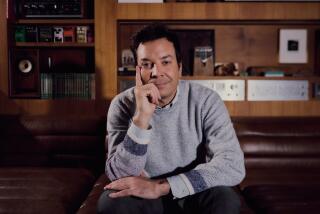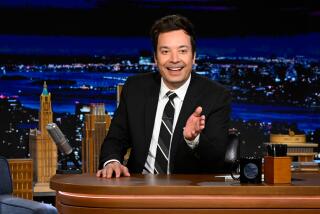Want solidarity in the time of coronavirus? Look no further than late-night TV
Back in the old days — a couple of weeks ago — live late-night television, where comedy and current events meet and mingle, was a regular event. Things are different now. And yet, with the ingenuity the moment demands, they are not as different as all that.
That talk shows have a cathartic part to play in maintaining the mental health of the nation, or a piece of it anyway, is not news. Now, along with the usual threats, we’re facing one both as local and as global as may be imagined, an enemy best fought literally by doing nothing. But as long as a laugh can be earned and shared, all is not lost. (Indeed, as a deliverer of crucial information, sprinkled with sugar, these shows can constitute a defensive weapon: Wash your hands.)
At first, and for it turned out only about a week, the plan for many of these shows was to go on as usual, but without an audience, with the crew and assorted, scattered staff members on hand for laughs. (What is the sound of no hands clapping during a comic’s monologue? Failure.) John Oliver taped the March 15 edition of his HBO series, “Last Week Tonight” — his second episode on the subject of the coronavirus — on a featureless white set reminiscent of a sci-fi clear room, or as Oliver said, “the place where movie characters go when they’ve just died.” Even with the help, the emptiness was palpable, and also pointed — a necessity and a lesson.
But as the world stepped back six feet, there was no responsible or practical alternative to packing up the studio and heading home. And so we enter, for the indefinite moment, a new era of live television, in which the term “remote broadcast” takes on a deeper meaning, as Stephen Colbert and Jimmy Fallon and Jimmy Kimmel and Samantha Bee and Trevor Noah and David Spade all continue to do their job by sheltering in place. (Seth Meyers is set to join them Monday; no word yet on James Corden, but one assumes plans are being made for life during quarantine.)
As new and, for the moment, as discomfiting as it can seem, this public private space is one in which we have lived easily for a long time now, on YouTube, Facebook, Instagram, Periscope, Twitch, Tik Tok and Snapchat — all have readied us for this day. FaceTime is just the home version of Jimmy Kimmel talking with Julia Louis-Dreyfus on his from-homecast, or Jimmy Fallon with Jennifer Garner on his. Meanwhile, professional and citizen humorists alike put up quarantine and coronavirus-related videos, to entertain themselves and potentially the world — do not insert “viral” joke here. It’s the 21st century version of putting on a show in somebody’s uncle’s barn. Such posts often make their way into late-night monologues.
The aesthetics, and indeed the mechanics, of this novel take — the casual dress, the direct address, the side-by-side Skype conversation, the portrait-format video selfie, the jump-cut edits, the absent audience, or one made of friends — are all familiar from web video and social media. I have had my issues with the culture’s ubiquitous screen use, which in normal times can seem the height of solipsism, a turning away from the physical world. But as fate would have it, we’re lucky to have those systems in place.
After the coronavirus shuts down production on late-night TV, Jimmy Fallon, Jimmy Kimmel, Trevor Noah and other hosts film mini-shows in their homes.

Indeed, the late-night shows have long been cozy with the internet, recycling viral videos, posting web extras, inviting viewer participation. Kimmel called for a #formalfriday, to encourage dressing up among the universally shut in, or even putting on clothes. (“For me, it’ll be the first time I’ve worn pants this week.”) Viewers were asked to send in videos. Wednesday, Fallon called for submissions in response to the hashtag #quarantineinsixwords, and read some out Thursday: “Fine you can paint daddy’s nails,” “Expelled my kid from home school,” “Flattening the curve, fattening my curves.” (“That’s a good one,” said Fallon, laughing.)
We can call this period transitional, as the sheltering will go on for quite a while, and all these series will be refined to fit the circumstances. Before they get the hang of it, hosts and guests alike are liable to seem a little less glamorous than usual. Minus the cosmetic adjustments, and in the doldrums of long, formless days, they might seem a little tired. Beards get stubbly, hair floppy.
But that, in a way, is the point. It’s a big boat, and we’re all in it. Indeed, you may have never had more in common with a celebrity. And absent a studio audience, the connection feels more personal, more confidential, more direct. (See: Mister Rogers.)
Not surprisingly, Stephen Colbert dressed for work on his first from-home monologue, wearing a suit (and airbuds), but hosting from a soap-bubbled bathtub (hygienic!). He went more casual for Day 2, out by his fire pit, his monologue accompanied by bird song and hickory smoke, and was dressed again for Day 3, on the porch. Other hosts were dressed as if every day were Saturday.
And if you’ve ever wanted to know what Colbert’s bathroom looked like, assuming of course this is his bathroom — it would feel like a betrayal of trust on more than one level if it weren’t — this unfortunate intersection of biology, easy travel and inadequate public policy has granted you the opportunity. This residential openness, too, is common to YouTube; privacy is more loosely defined there. Fallon lives in a house apparently decorated by elves, with a tubular slide leading from the second to the ground floor. It already looks like a talk-show set.
Bee also went home, or at any rate to a woodshed on what one takes to be her own wooded property. (“Hi there, I’m Samantha Bee and I’m just hanging out at home fully made up.”) Her first broadcast saw her attempting to chop wood; in the second, she and husband, Jason Jones (off camera), argued over whether the phrase “washing your hams” constituted a pun. (Bee was, in fact, washing a ham.) She calls the series, posted on the “Full Frontal” YouTube page, “Beeing at Home.”
Families are more heard about than seen, though Fallon’s small daughters crawl all over him, interrupting or contributing to the show — the interruptions are also contributions, of course. Sharing the stage with them makes Fallon, whose wife, Nancy, films his segments, seem a little more grown-up. (A little more: He’s still all, “Jennifer Garner, you’re awesome! Thank you so much for being a guest on our show!”) The kid factor — Kimmel jokes about hiding from his, but his opening credits are their work — is cuter than I would have imagined.

Absent the glitz and glitter, the hosts are still recognizably, perhaps more essentially themselves. Kimmel, who has the air of being an average Joe telling you what confounds him, and a comic only incidentally, does very well in this setting. Colbert is composed, dry, ironic. Fallon rushes through his monologue as if it stands in the way of getting to the fun.
Noah is thoughtful, playful, a little angry and younger than the rest. After a few smartphone posts, his home show went full monologue-and-Skype-chat by the week’s end (“From Trevor’s couch in New York City to your couch somewhere in the world ... it’s the Daily Social Distancing Show”). Spade is the boyish old-timer whose degree of discontentment is impossible to gauge.
Most, maybe all, are raising money for charity within the context of their posts.
There is something oddly comforting about these dispatches. For all their dreadful novelty, they’re also a reminder that not everything is abnormal. People make jokes, talk with their friends, deal with their kids. (Those television personalities were always speaking to you from some other place, anyway.) The conversations are chummy. Kimmel and Dreyfus talk about baking, Fallon and Lin-Manuel Miranda about home schooling. (Miranda: “Getting work done? I’m learning how to teach math.”) At the same time, they acknowledge the present unreal reality, and set an example. Indeed, their very homemade nature sends a message of solidarity. We’re all leading constricted, improvisational lives now.
“I spend a lot of time right over there in Manhattan,” Colbert said from his porch, looking eastward, “pulling together the biggest stories of the day, broadcast quality cameras at a professionally lit theater to bring you the monologue that is my monologue. But sometimes I like to self-quarantine, put an iPad on top of a plant stand, sit on my back porch and deliver [a] slapdash web streaming low-res manifesto of news.”
“Obviously we do the show for you, but the secret is we do the show with you,” Colbert said at the end of his third home-brewed broadcast. (He is taking an already-planned break now.) There is no doubt that when this war is over, Stephen and Samantha and Jimmy and Jimmy and Trevor and James and David and every other TV host or show that welcomes a studio audience will welcome them back again. And we will welcome them, as well, as a sign that community is physical again, and we can thrill again to the sound of many hands clapping.
More to Read
The complete guide to home viewing
Get Screen Gab for everything about the TV shows and streaming movies everyone’s talking about.
You may occasionally receive promotional content from the Los Angeles Times.







